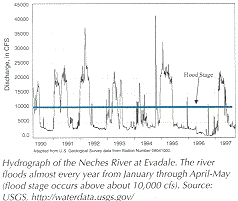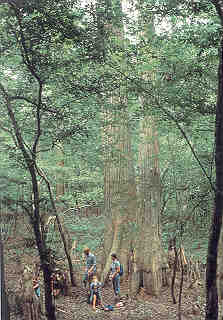Where are they?
Riverine forested wetlands are found on the floodplains of rivers and streams that cross the middle and upper coastal plain. The larger rivers of the wet upper coast, such as the Sabine, Neches, Trinity, and Brazos Rivers, have broad floodplains that support extensive forested wetlands. Smaller rivers and streams of the semiarid lower coast do not flood for long enough periods to support extensive forested wetlands.
Swamps are the wettest type of riverine forested wetland in Texas. True swamps are found mostly in East Texas, from Houston east to the Sabine River. Bottomland hardwood forests, the most common type of riverine forested wetlands on the upper and midcoast, are not as wet as swamps.
Geology and Soils
The floodplain soils of the riverine wetlands are all relatively young compared to the adjacent upland soils. Floodplain soils are constantly renewed by continual sedimentation, such that sedimentary stratification is still evident in many of these soils. Nearly all floodplain surfaces on the Texas coast are well under 10,000 years in age, and most are under 1,000 years old. Clayey soils predominate. Organic soils are rare.
Soil Profile of a Bottomland Hardwood Forest
(Fausse Soil Series, slough in low terrace of Trinity bottom, Liberty County)
The surface soil to about 5 inches is a slightly acid dark grayish brown clay with many fine iron stains along old root channels. The subsoil to 60 inches is a dark gray clay which grades from neutral in the upper part to slightly alkaline in the lower part. Iron stains are common throughout the subsoil. The clay is very sticky and very firm throughout the profile.
The soil is continuously saturated below a depth of 18 inches in most years, and is flooded or ponded several times a year for brief to very long periods.
(from the Liberty County Soil Survey)

Hydrograph of the Neches River at Evadale. The river floods almost every year from January through April-May (flood stage occurs above about 10,000 cfs). Source: USGS,
Hydrology
Overbank river flooding is the primary source of water for forested wetlands. On floodplains with distinctive wetland character, flooding occurs in most years and the flooding persists for at least several weeks at a time. Only the larger rivers have large-enough watersheds to maintain this kind of flooding. Most bottomland hardwood forests have flooding periods that range from a few weeks to several months. Swamps, on the other hand, stay flooded for much longer periods of time, and in fact may only dry out occasionally. The swamp forests occur in sloughs and other depressional features of floodplains, and occasionally in low floodplain terraces where runoff from rainfall may be the dominant source of water. Flooding periods decrease as one moves south along the coast and the climate becomes more arid.
Vegetation
The dominant trees of most swamps are bald cypress and water tupelo. Water hickory, water locust, black tupelo, planertree and many others are also commonly found in the swamps.
On the upper coast, bottomland hardwood forests are dominated by willow oak water oak, overcup oak, cherrybark oak, laurel oak, green ash, red maple, black willow, water tupelo, and others. Understory vegetation often consists of dwarf palmetto, Cherokee sedge, deciduous holly, yaupon, and many others. On the mid-coast, pecan hickory, American elm, cedar elm, water oak, live oak, green ash, hackberry/sugarberry, and sycamore often dominate the forests. The understory is similar to that of the upper coast.
Animals
Animals found in forested wetlands include bald eagles, wading birds, ducks, woodpeckers, warblers, frogs, salamanders, turtles, snakes, alligators, bats, rabbits, beaver, squirrels, bobcats, foxes, river otters, raccoons, and deer. Many river fishes such as gars, suckers, minnows and shiners, catfishes, bass, and sunfishes use flooded swamps and bottomland forests as feeding and breeding habitats.
Threats
Forested wetlands are perhaps the most rapidly disappearing wetland type in the United States. Agriculture and silviculture (pine plantations) are the major continuing threats to these wetlands. The character of a forested wetland is destroyed if all of the trees are cut down, even if the hydrology is not otherwise altered, and the wetland may require a hundred or more years to recover. Most of the swamp forests underwent severe deforestation in the early part of this century as high-quality cypress was over-harvested. These swamps are still in a recovery mode today. Many forested wetlands can be logged on a sustainable basis and still retain their major ecological functions.
Another major threat is the construction of dams and reservoirs on the rivers that supply water to these wetlands. In addition to the clearing or drowning of forested wetlands within reservoir floodpools, there is a long-term threat that results from the flood-control function of most dams. Once annual flooding is removed, the wetlands begin to dry out and become more susceptible to development pressures. Since the mid-1950s, forested wetlands on the Texas coast have decreased in area by about 11 percent, a net loss of more than 96,000 acres.
Ecological Functions and Human Values
In addition to providing timber and habitats for plants and animals, forested wetlands provide other valuable goods and services. These wetlands store floodwaters and dampen river flood crests, helping to control flood damage and erosion. They also improve human water supplies by filtering out sediments, nutrients, and pollutants; and by stabilizing river flows and groundwater levels. The fish and wildlife habitats help support fishing, nature tourism, hunting, and other recreational uses.

